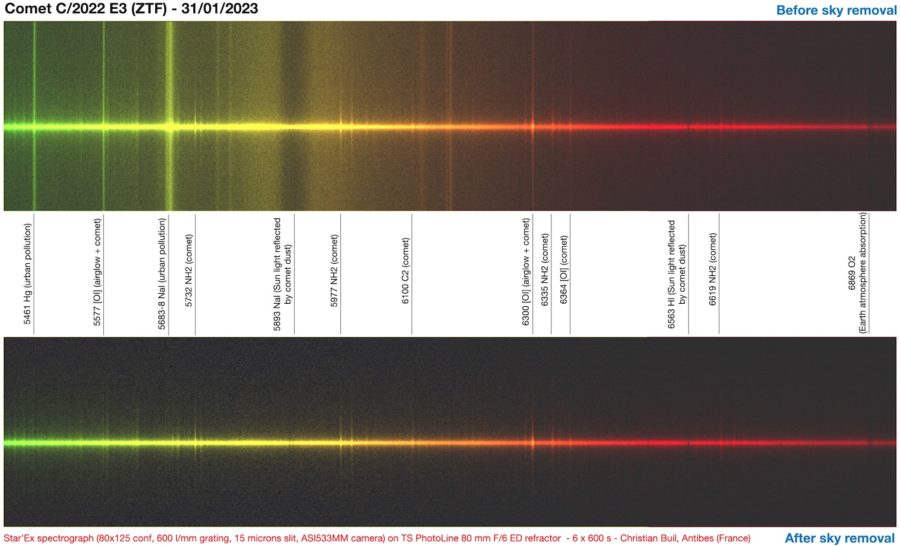Recent Comet Activity in Southern California: An Explanation by Senior NASA Analyst
March 2022 — C/2022 E3 (ZTF), colloquially known as ‘The green comet’, was discovered by the Zwicky Transient Facility(Palomar, CA), where it was initially mistaken for an asteroid.
50,000 years ago, a small green comet flew past a planet of neanderthals and wooly mammoths.
Less than a month ago, it flew past a planet of satellites and supercomputers.
Having passed closest to the sun on January 12th, and closest to the Earth between the first and second of February, this comet likely hails from the Oort Cloud- a ‘bubble’ of mostly icy objects on the very edge of the solar system, roughly two light years from earth. For reference, the earth is only about 8 light minutes from the sun.
According to Jon Giorgini, a senior engineer at JPL, “C/2022 E3 appears to have originated in the Oort cloud, a distant region of icy objects far past the orbit of Pluto that surrounds the solar system. At some point many 10s of thousands of years ago, something happened that caused C/2022 E3 to slowly start falling in toward the Sun — perhaps a chance gravitational nudge from another passing object or some other combination of tiny forces tipped the balance and began its long fall toward the inner solar system.”.
“We may have just discovered it, but C/2022 E3’s approach to Earth has been a long time coming, the date inevitable for thousands of years (all of human history),” Giorgini shares.
Using spectroscopy, scientists have also pinned the comet’s radiant green glow on the presence of diatomic carbon and cyanogen.
As explained by Giorgini, “It turns out that atoms and molecules absorb and emit energy in fixed ways that are unique to each substance, like a fingerprint. It has to do with the electrons spinning around the nucleus needing an exact amount of energy to change levels. When they get that amount of energy, they jump to another level, absorbing or emitting a fixed amount of energy. This is a fundamental thing about each kind of atom that can’t change no matter where they are.”
“So when an object is lit up, this creates a pattern of energy emission and absorption in the reflected light that reveals what kinds of atoms are reflecting the light. People do this all the time. We interpret the overall result as the color of an object, with its mix of different atoms reacting to the energy of the light hitting it. But to precisely identify composition, the reflected light is passed through a prism that spreads it out and makes it easier to see the pattern of emissions and absorption unique to each chemical. This is called “spectroscopy”. Its light has been passed through a prism and spread out so you can see all the components that people’s eyes normally add together into a color.” Giorgini explained to The Gazette.
Giorgini continued, “The bright and dark lines are the emission and absorption patterns created by the comet’s chemicals reflecting light. This pattern provides a “fingerprint” to identify what a distant object is made out of — by comparing with substances we test on Earth that produce the same pattern.”
How are the trajectories of celestial objects calculated?
Giorgini states “Observers use telescopes to measure the position of the comet relative to background stars. Those background stars have known coordinates like latitude and longitude on a globe, except called “declination” and “right ascension” in the sky coordinate system. As the comet moves across the sky, measurements of position in right ascension and declination are reported from telescopes around the world. We can fold all of them in together and determine what sort of motion it must have so as to match all those observations. The more measurements you have, and the longer the time span they cover, the more limited are the [possibilities] for motion that can satisfy all of the measurements and the gravitational physics of the solar system simultaneously.”
“ For C/2022 E3, 6660 position measurements have been reported so far by 135 different observatories over the time-span 2021-Jul-10 to 2023-Feb-21,” Giorgini said.
Currently, NASA tracks over 28,000 NEOs (near-earth objects) and has identified over a million asteroids. This is done both for research purposes- asteroids that have remained untouched since the beginning of our solar system can teach us more about the conditions under which it was formed — and to identify possible hazards while they can still be combated.
When asked how much in the way of resources NASA puts towards tracking phenomena like C/2022 E3, Giorgini stated: “Well, NASA spends a few 10s of millions of dollars on ground observatory
programs, mostly geared to finding hazardous asteroids that could impact the Earth. This includes building new, more sensitive telescopes that automatically scan the sky.
NASA is spending an additional $100 million per year to build a new space-based observatory called “NEO Surveyor”, which will efficiently and rapidly find small solar system objects from [the] vantage point of space where, without an atmosphere spreading the light around, it is always a dark sky unless you are looking directly at the Sun. This mission is scheduled to launch in 2028.”
These projects help us all, by creating jobs, helping us understand how the universe works and aiding in the detection of potential threats. These marvelous feats of engineering are what allow us to truly appreciate the astronomical journeys of comets like C/2022 E3, which so briefly appear in our skies.
We have changed so much since it was last here. One can only hope that humanity will live long enough to see it again.

Claire Brounsten has been a devoted writer since childhood, and with no intentions of stopping anytime soon. Now in 12th grade, and a writer and editor for the Grizzly Gazette’s Community News Team, she’s taking her passions a step forward in the hopes of helping those around her. Currently, she aims to cover topics regarding science, history, politics, and sociology- all of which have captivated her for years- and share that intrigue and information with others. Understanding how the world works, and how the systems in place impact our everyday lives, are the first steps towards navigating it.
So, for Claire, being a journalist means having the opportunity to provide people with the tools needed to make a tangible change within their own lives. She aspires to not only explore how and why the world works the way it does, but enable and empower as many people as she can to change it.



















